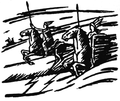
In Norse mythology, Rán is a goddess and a personification of the sea. Rán and her husband Ægir, a jötunn who also personifies the sea, have nine daughters, who personify waves. The goddess is frequently associated with a net, which she uses to capture sea-goers. According to the prose introduction to a poem in the Poetic Edda and in Völsunga saga, Rán once loaned her net to the god Loki.

In Norse mythology, Snotra is a goddess associated with wisdom. Snotra is solely attested in the Prose Edda, written in the 13th century by Snorri Sturluson. Scholars have proposed theories about the implications of the goddess.
In Norse mythology, Vör is a goddess associated with wisdom. Vör is attested in the Prose Edda, written in the 13th century by Snorri Sturluson; and twice in kennings employed in skaldic poetry. Scholars have proposed theories about the implications of the goddess.
In Norse mythology, Lofn "the comforter, the mild," or "loving" is a goddess. Lofn is attested in the Prose Edda, written in the 13th century by Snorri Sturluson and in kennings found in skaldic poetry. In the Prose Edda, Lofn is described as gentle in manner and as an arranger of marriages, even when they have been forbidden. Scholars have proposed theories about the implications of the goddess.
In Norse mythology, Syn is a goddess associated with defensive refusal. Syn is attested in the Prose Edda, written in the 13th century by Snorri Sturluson; and in kennings employed in skaldic poetry. Scholars have proposed theories about the implications of the goddess.
In Norse mythology, Mist is a valkyrie. Mist appears in valkyrie list in the Poetic Edda poem Grímnismál and both of the Nafnaþulur valkyrie lists. No further information is provided about her. Rudolf Simek says that her name, Mist, is likely related to Old Norse mistr, meaning "cloud, mist," and that this "reminds us of the way in which valkyries can ride through the air and over water," such as in the Poetic Edda poems Helgakviða Hjörvarðssonar and Helgakviða Hundingsbana II.

In Norse mythology, Gríðr is a female jötunn who is the mother of the god Víðarr by Oðinn.
In Norse mythology, Sjöfn is a goddess associated with love. Sjöfn is attested in the Prose Edda, written in the 13th century by Snorri Sturluson; and in three kennings employed in skaldic poetry. Scholars have proposed theories about the implications of the goddess.
Darraðarljóð is a skaldic poem in Old Norse found in chapter 157 of Njáls saga. The song consists of 11 stanzas, and within it twelve valkyries weave and choose who is to be slain at the Battle of Clontarf. Of the twelve valkyries weaving, six of their names are given: Hildr, Hjörþrimul, Sanngriðr, Svipul, Guðr, and Göndul. Stanza 9 of the song reads:
In Norse mythology, Auðr is the son of the personified night, Nótt, fathered by Naglfari, and uncle of Thor. Auðr is attested in the Prose Edda, written in the 13th century by Snorri Sturluson, and in the poetry of skalds.

In Norse mythology, the goddess Rán and the jötunn Ægir both personify the sea, and together they have nine daughters who personify waves. Each daughter's name reflects poetic terms for waves. The sisters are attested in the Poetic Edda, compiled in the 13th century from earlier traditional sources; the Prose Edda, written in the 13th century by Snorri Sturluson; and in the poetry of skalds. Scholars have theorized that these daughters may be the same figures as the nine mothers of the god Heimdallr.
In Norse mythology, Þrúðvangr or Þrúðvangar is/are a field/fields where the god Thor resides. The field is attested in the Prose Edda and in Heimskringla, both written by Snorri Sturluson in the 13th century.
In Norse mythology, Kára is a valkyrie, attested in the prose epilogue of the Poetic Edda poem Helgakviða Hundingsbana II.

In Norse mythology, Herfjötur is a valkyrie. Herfjötur is attested as among the 13 valkyries listed in the Poetic Edda poem Grímnismál, and in the longer of the two Nafnaþulur lists found in the Prose Edda.

In Norse mythology, Herja is a valkyrie attested in the longer of the two Nafnaþulur lists found in the Prose Edda.

In Norse mythology, Geiravör is a valkyrie attested in the longer of the two Nafnaþulur lists found in the Prose Edda.

In Germanic mythology, an idis is a divine female being. Idis is cognate to Old High German itis and Old English ides, meaning 'well-respected and dignified woman.' Connections have been assumed or theorized between the idisi and the North Germanic dísir; female beings associated with fate, as well as the amended place name Idistaviso.
In Norse Mythology, Helreginn is a jötunn listed in the þulur section of the Prose Edda book Skáldskaparmál. Other than the name, no additional information about the figure is provided. Rudolf Simek comments that the name is unusual, reasoning that it is unusual for the jötnar to be directly associated with "the underworld."










